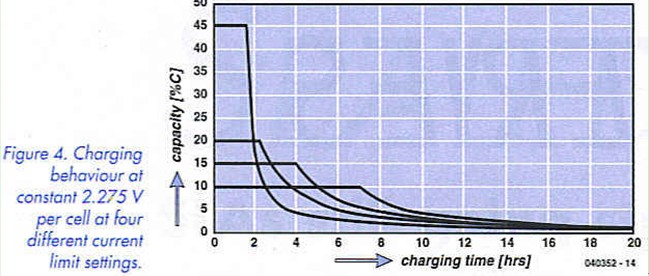

Project Solutions
SEALED LEAD-ACID BATTERIES (2)
Published:2011/8/8 1:45:00 Author:Phyllis From:SeekIC
Charging
In principle sealed lead-acid batteries can be charged at a constant voltage. The maximum charge voltage that can be used depends on the temperature, and it is important that this voltage is not exceeded during charging. Figure 2 shows the relationship between temperature and voltage for two different charging regimes. The higher value is used for normal (cyclical) operation, while the lower value is for when the battery is trickle-charged to maintain its condition over a long period. In standby operation a voltage that is even only slightly too high will have a negative impact on the life of the battery, and so if the operating temperature will not be constant a temperature-compensated charging circuit is essential. What can happen if the charge voltage is not adjusted to suit the temperature is clearly shown in Figure 3. 

Charging at constant voltage is very simple. Any regulated power supply can be used as long as its output voltage can be set to the correct value. At room temperature (20 CC) a value of 2.45 V (say between 2.4 V and 2.5 V) per cell is suitable for normal cyclical charging; for trickle charging a suitable value is 2.275 V (say between 2.25 V and 2.3 V) per cell. Cells should not be charged for too long at higher voltages. One criterion that can be used to determine when to stop charging is to test when the charge current, which falls continuously during the first few hours of charging, reaches 0.07 CA (or less) and remains unchanged for three further hours. If this test is not used, then time-controlled charging should be limited to a maximum of 16 to 20 hours.
The initial charge current is determined by the internal resistance (or, if available, current limiting) of the power supply. Raising the maximum initial current does not reduce the charge time as much as might be expected. 
Figure 4 shows how the charge current changes when the charge voltage is set to 2.275 V using four different current limit settings. The charge current (in amps) is shown on the vertical axis as a percentage of the battery capacity CJQ- If the C\Q capacity is, for example, 1 Ah, then we are considering initial currents from 450 mA (or 45 % of C10) down to 100 mA (10% of C10). The figure shows that the initial limit current only Rows at the beginning of the charge cycle. The current proceeds to fall off exponentially, almost to zero at the end of the charging procedure. Manufacturers recommend initial current limit values in the range from 0.25 CA to 0.4 CA; values above 0.5 CA are best avoided in the interests of preserving the life of the battery.
Reprinted Url Of This Article: http://www.seekic.com/blog/project_solutions/2011/08/08/SEALED_LEAD_ACID_BATTERIES__(2).html
Print this Page | Comments | Reading(685)
Article Categories
New published articles
· Imagination works with TSMC to develop FinFET process
Author:Ecco Reading(30184)
· XMOS pushes event-driven MCUs with lower price
Author:Ecco Reading(3461)
· Intel brings upgraded 32-nm SoC for smartphones
Author:Ecco Reading(3181)
· Micron pushes TLC 128-Gbit NAND flash
Author:Ecco Reading(3661)
· Intel will stop supplying desktop motherboards
Author:Ecco Reading(5231)
· Processor market was expected to regain strength in 2013
Author:Ecco Reading(3248)
· It was reported that TSMC sales fall steeply
Author:Ecco Reading(3390)
· Cisco, NXP work with auto wireless startup
Author:Ecco Reading(3530)
· Micron was impacted by manufacturing glitch
Author:Ecco Reading(3935)
· China can make 22-nm transistor by themselves
Author:Ecco Reading(3707)
· Chip market rebound is coming, according to survey
Author:Ecco Reading(3677)
· Sony, Toshiba will spend more on chips, iSuppli reports
Author:Ecco Reading(3714)
· Qualcomm becomes the 13th company to join NFC Forum board
Author:Ecco Reading(6028)
· TSMC increases building work for FinFET fab
Author:Ecco Reading(3692)
· TI plans to cut 1,700 jobs in OMAP shift
Author:Ecco Reading(4478)